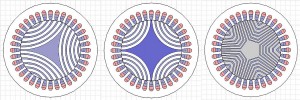Doubly Excited Brushless Reluctance Machine for Advanced Wind Power Generation
Longya Xu, The Ohio State University
A doubly excited brushless reluctance machine (DEBRM) consists of two major parts: the dual winding stator and segmental rotor. Two sets of stator windings, one acting as the main winding and the other, the power control winding, are placed in the stator core sinusoidally. The rotor consists of several magnetically isolated reluctance segments. The DEBRM wind turbine generator can be structured for both ac and dc power grid connections. Features include no windings, no brushes or slip rings on the rotor, low cost, easy maintenance, and high reliability, with a greatly simplified cooling system.
Three DEBRMs with different sets of pole-number combinations on the primary and secondary windings using the same machine frame were designed and analyzed. Figure 6 shows three cross-sections.
The three DEBRMs were evaluated for their mutual coupling effectiveness, back EMF induction, and torque production. The pole combination used in left-hand side of Figure 7 seemed most effective in primary/secondary mutual coupling and had the least torque ripple and highest torque production. A prototype was built. Figure 7 shows the rotor lamination and prototyped rotor.
Initial testing was conducted on the prototype DEBRM for the no-load and loaded characteristics. The estimated torque capability of the prototype is 15Nm, 2850w power output, and 88% efficiency at 1800 rpm. Tests verified that a wind turbine generator built based on DEBRM is very rugged and convenient to control. In the doubly-fed operational mode, the inverter capacity is only a fraction of the total system capacity, thus reducing system costs.
This research was supported by the Grainger Center for Electric Machinery and Electromechanics.

